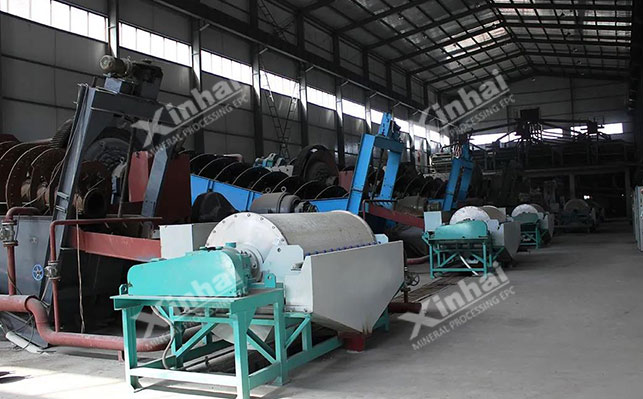With the rapid development of the steel industry, easily accessible iron ore resources are gradually diminishing, making the development and utilization of hard-to-process ores a focal point of research. Oolitic hematite, a form of challenging iron ore, despite its abundant reserves, has been limited in its development and utilization due to its complex mineral structure and grinding challenges. This study aims to identify effective beneficiation techniques for low-grade oolitic hematite to enhance resource utilization efficiency.

An analysis of the ore properties of a low-grade oolitic hematite in Yunnan reveals that the primary metallic minerals are hematite and minor limonite, with gangue minerals primarily being quartz and chlorite. The ore predominantly features an oolitic granular structure with grains ranging from 0.3 to 1.2 mm, consisting of concentric layers of very fine-grained hematite interspersed with parallel layers of chlorite or limonite.
(1)Test plan
The purpose of the beneficiation test is to achieve preliminary enrichment of iron in iron concentrate. The reduction roasting weak magnetic separation process, strong magnetic separation flotation process, single strong magnetic separation process, and strong magnetic separation shaking table reselection process were compared.

(2) Reduction roasting weak magnetic separation test
The reduction roasting weak magnetic separation process is a traditional beneficiation method for difficult to select iron ores. This process first reduces and roasts the ore to enhance the magnetic properties of iron minerals, and then separates them through a weak magnetic separator. In this study, after reduction roasting, the raw ore was subjected to multiple selections using a weak magnetic separator in order to obtain high-grade iron concentrate. The experimental results show that although the roasting weak magnetic separation process can improve the iron grade, it is accompanied by higher production costs and lower iron recovery rates, which limits its application in the beneficiation of low-grade oolitic hematite.
(3) High intensity magnetic separation flotation test
The strong magnetic separation flotation process uses strong magnetic separation as a pretreatment step to remove some gangue from the ore, and then further enriches iron minerals through the flotation process. In this study, the strong magnetic separation flotation test includes two methods: forward flotation and reverse flotation. Positive flotation uses surfactants to attach iron minerals to bubbles for enrichment, while reverse flotation uses inhibitors to attach gangue minerals to bubbles for separation of iron minerals. The experimental results show that the strong magnetic separation flotation process has limited effectiveness in improving iron grade and has weak adaptability to ore properties.
(4) Single strong magnetic separation process
The single strong magnetic separation process is a low-cost beneficiation method suitable for separating magnetic minerals from non-magnetic minerals. In this study, a single high-intensity magnetic separation process achieved efficient recovery of iron minerals by adjusting the magnetic field strength and grinding fineness. The experimental results show that this process can obtain low-grade iron concentrate while ensuring a high iron recovery rate, which is suitable for processing low-grade oolitic hematite.

(5) Strong magnetic separation shaking table reselection process
The strong magnetic separation shaking table reselection process is a method of mineral separation that comprehensively utilizes magnetic properties, density, and particle size differences. In this study, non-magnetic gangue was first removed using a strong magnetic separator, followed by preliminary separation based on density differences using a shaker, and finally, the grade of iron concentrate was further improved through a gravity separation process. The experimental results show that this process can effectively improve the grade and recovery rate of iron concentrate, and is an ideal low-grade oolitic hematite beneficiation process.
Taking into account the cost of mineral processing and the quality of iron concentrate products, both the single strong magnetic separation process and the strong magnetic separation shaking table gravity separation process are suitable for the stage grinding stage. Both processes can produce iron concentrates that can be sold as low-grade iron concentrates, and can be used in industrial applications in combination with high-grade hematite concentrates.
The study on the beneficiation process of low-grade oolitic hematite shows that the single strong magnetic separation process and the strong magnetic separation shaking table gravity separation process are effective methods for processing this type of ore. Both processes can obtain marketable iron concentrates and have good ore blending and utilization value in industrial applications.